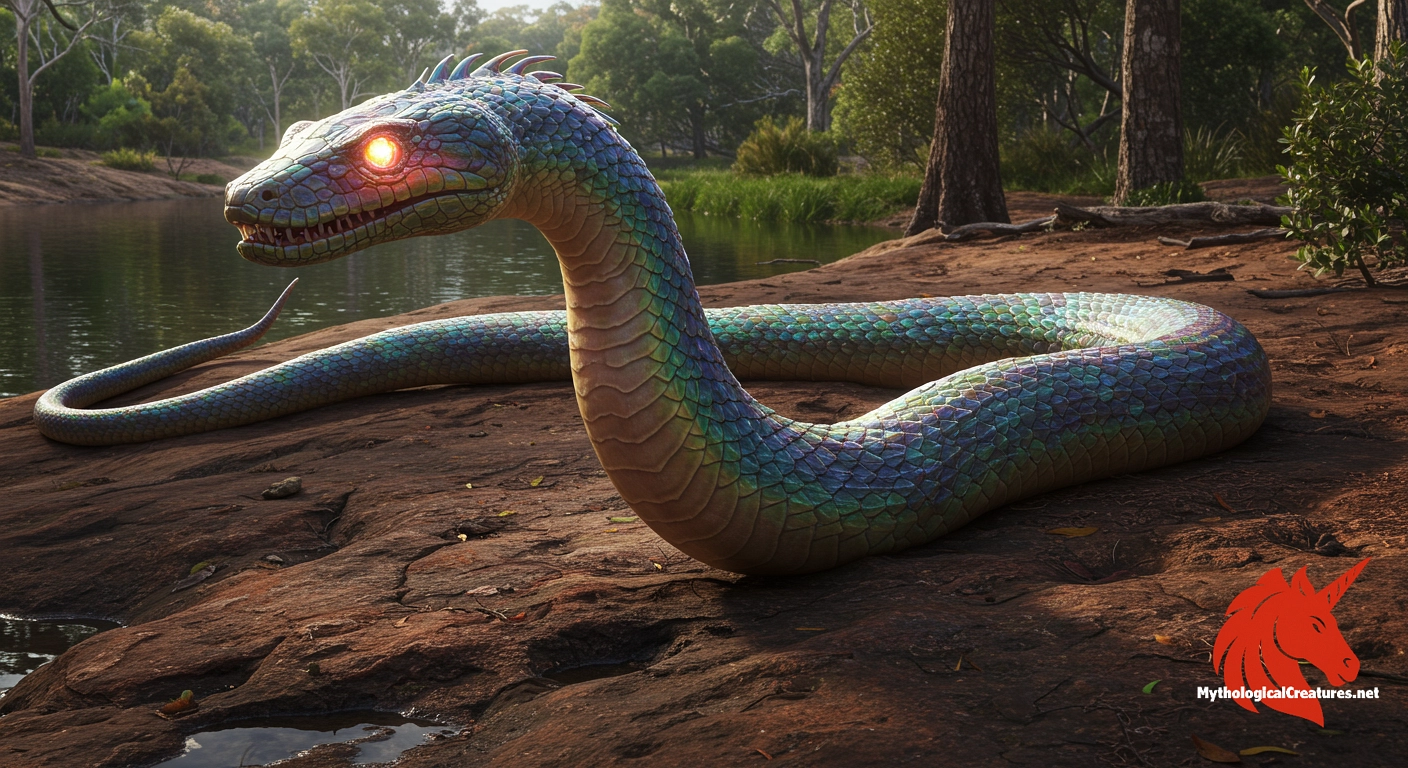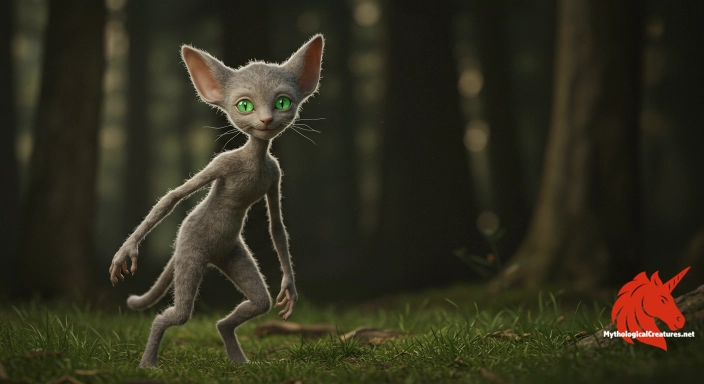Rainbow Serpent: The Rainbow Serpent is a powerful and revered creator deity in Australian Aboriginal mythology.

Rainbow Serpent
Rainbow Serpent - A central figure in Aboriginal mythology, the Rainbow Serpent embodies the duality of creation and destruction and plays a vital role in sustaining life through water.
Origins & First Encounters
The Rainbow Serpent emerges from the heart of Indigenous Australian mythologies as an embodiment of creation and transformation, woven intricately into the fabric of Dreamtime stories. Its origins echo across time, with ancient traditions attributing to it the power to shape landscapes and dictate the rhythm of life. This deity is celebrated as both a nurturer and a force that can unleash chaos, reflecting nature’s dual capacity for creation and destruction. Indigenous communities have long regarded the Serpent as a living embodiment of natural law, a guiding presence whose winding path carved rivers and valleys. Oral narratives and rock art have immortalised its tale, ensuring that its legacy endures through generations. The being is not merely a myth but a spiritual catalyst that connects people to the land and its seasonal cycles. Its vibrant imagery and mystical allure have made it a central figure in ceremonial practices and cultural rites. The Rainbow Serpent’s story, though varied in detail, consistently underscores themes of rebirth and the sanctity of water as a source of life. Its enduring presence continues to inspire community identity and artistic expression within Aboriginal cultures. The myth remains a poignant symbol of the natural and spiritual worlds in harmonious dialogue.
Source Texts & Tale Variants
The ancient oral traditions of Australia have safeguarded countless narratives of the Rainbow Serpent, passed down through generations with remarkable fidelity. Traditional storytelling, song, and ritual recitations have all served as vessels for the myth, enriching its manifold interpretations. Indigenous rock art and ceremonial sites stand as tangible records of these traditions, bearing the marks of a timeless creative spirit. Unique regional versions of the myth have been preserved by different language groups, each adding layers of meaning to the Serpent’s lore. Early encounters with European settlers offered additional, though fragmentary, documentation of these stories. Ethnographic research over the past century has highlighted the diversity and depth of these accounts, reinforcing the importance of oral history. Community elders continue to share these narratives in ceremonial contexts, ensuring that the myth remains a living tradition. Artistic depictions in body painting, weaving, and carving have further solidified the Serpent’s role in cultural memory. These narrative sources are not static; they evolve with the community, reflecting changes in the environment and societal values. The multiplicity of sources underscores the notion that the Rainbow Serpent is as dynamic and multifaceted as the natural phenomena it represents.
Form & Powers
Visually, the Rainbow Serpent is most often rendered as a lengthy, undulating figure whose sinuous form meanders gracefully across the landscape. Its body is adorned with a dazzling spectrum of colours that evoke the shimmering arc of a rainbow after a rainstorm. Each scale is depicted with intricate detail, suggesting an iridescence that captures both the softness of light and the intensity of natural energy. The creature’s form may vary from colossal proportions that dominate the horizon to a more intimate presence associated with local water sources. Artistic portrayals often endow the Serpent with luminous, all-knowing eyes and a majestic aura that commands both reverence and awe. The texture of its skin is sometimes illustrated as smooth and reflective, while in other renditions it appears rugged and adorned with symbolic markings. The interplay of light, shadow, and colour enhances the creature’s mysterious allure, making it appear almost otherworldly. Its flexible, flowing contours are emblematic of the fluidity of water and the continuous cycle of renewal in nature. Some representations include additional attributes such as ornate fins or subtle spiralling patterns along its body for symbolic emphasis. Overall, every physical detail serves not only an aesthetic purpose but also a metaphorical one, linking the tradition to the vibrant forces of nature.
Regional Faces
Local interpretations of the Rainbow Serpent reveal a rich tapestry of cultural variations across Australia’s diverse landscapes. In arid inland regions, the Serpent is often revered as a mystical water guardian whose meandering path ensures the replenishment of vital waterholes during drought. By contrast, communities near the coast or major river systems emphasize its role as a dynamic force that governs the cycles of flooding and fertility. These regional narratives adapt the myth to the specific environmental conditions, aligning the creature’s attributes with local climatic phenomena and landforms. Variations in its name and ritual depiction highlight a deep connection with the local topography, allowing each group to infuse unique symbolic layers into the mythology. Colour schemes in artistic renditions may shift subtly based on regional flora and landscape, reinforcing local identity. Some traditions portray the creature as a gentle, benevolent being, while others stress its formidable, destructive potential. Ceremonies and seasonal rituals are often tailored to reflect these localised interpretations, ensuring that the myth remains deeply relevant to community life. Such adaptations serve as a testament to the adaptability and enduring resonance of the myth within various ecological contexts. Ultimately, regional variations of the Rainbow Serpent mirror the diversity of Australia’s natural environment and cultural heritage.
Cultural Parallels
Comparative mythological studies reveal that the motif of a primordial serpent entwined with themes of creation, renewal and destruction is a recurring archetype across many cultures. Similar to the Rainbow Serpent, figures such as the feathered serpent in Mesoamerican traditions also embody the dual forces of nurturing and chaos. In several Asian cultures, serpentine beings are revered as symbols of wisdom and natural potency, drawing parallels with the spirit embodied in the Aboriginal myth. Such figures, while differing in narrative details, share a universal symbolism that bridges the gap between natural phenomena and human understanding. The interweaving of water, colour and creation in the Rainbow Serpent myth finds resonances in various global traditions that celebrate the cyclical nature of the world. Both the Rainbow Serpent and its cross-cultural counterparts evoke a deep respect for environmental forces and the mystery of life. Comparative analysis highlights how myth serves as a conduit for exploring complex relationships between humanity and nature. Artistic depictions around the world often employ fluid lines and dynamic colour palettes, reflecting a shared human response to the awe of the natural world. This cross-cultural dialogue enriches our appreciation for the Rainbow Serpent, situating it within a broader global mythological landscape. Through its comparative study, the Rainbow Serpent is seen not only as an isolated myth but as a part of a universal narrative expressing humanity’s enduring bond with the earth.
Legacy & Modern Evolution
The legacy of the Rainbow Serpent has evolved significantly over time while remaining a central symbol of Indigenous Australian spirituality. Initially entrenched in the sacred contexts of the Dreamtime, its image symbolised the intimate bond between the people and the land. Over centuries, depictions of the Serpent have broadened, transitioning from exclusive ceremonial representations to widely recognised cultural icons. Contemporary artists and community leaders repurpose this myth in forms ranging from public art to popular festivals, ensuring its continued relevance in modern society. The Rainbow Serpent now frequently appears in discussions surrounding environmental stewardship, spiritual resilience, and cultural revival. Modern reinterpretations maintain links to traditional narratives while also addressing contemporary issues such as ecological conservation and social justice. Events like the Rainbow Serpent Festival celebrate not only the myth but also the creative and dynamic spirit of its legacy. In these modern expressions, the ancient narratives are reimagined to include a dialogue between past and present. The myth continues to challenge and inspire, reminding contemporary audiences of the enduring power of nature. Ultimately, the evolution of the Rainbow Serpent from ancient myth to modern symbol underscores its timeless allure and its vital role in the cultural identity of Indigenous Australians.
Interesting Fact
One fascinating aspect of the Rainbow Serpent is its simultaneous embodiment of both creation and destruction, highlighting the Aboriginal understanding of nature's dual forces.
Quick Creature Info
Origin:
Associations:
Our Mythic Legendary Rating:

Also Sometimes Known As:
Habitat:
Supernatural Powers:
Physical Attributes:
Abilities:
Behavior:
Lore:
Related Creatures, Tales or Lore
- QQuetzalcoatl
- NNaga
- JJörmungandr
References
Discover Another Mythical Legend You May Not Have Heard Of?
Uncover the mysteries of ancient folklore and expand your knowledge of legendary beings from cultures around the world.
Dare to Meet the Hinzelmann....
Mythical Disclaimer: The images and data on this site are derived from various historical and literary sources, but we have found that many myths often have multiple versions and interpretations across references, sometimes contradictory. As a result, these creature depictions are artistic interpretations—imaginative blends of folklore, legend, and a dash of AI guesswork. Because creature descriptions vary widely, our illustrations and accompanying information represent our best effort to honor mythology while bridging creative gaps. Enjoy these interpretations—just remember, we've done our best to respect the stories and validate available data, but in the realm of mythology, details often shift, imagination leads the way, and nothing is ever set in stone!
Curated by the Mythological Creatures Team (rev. May 2025)
